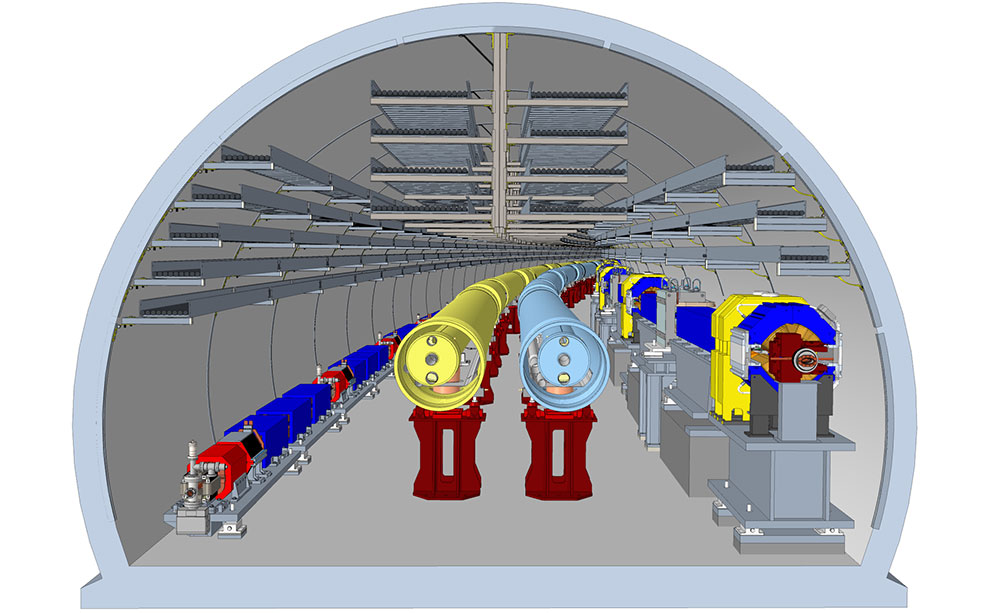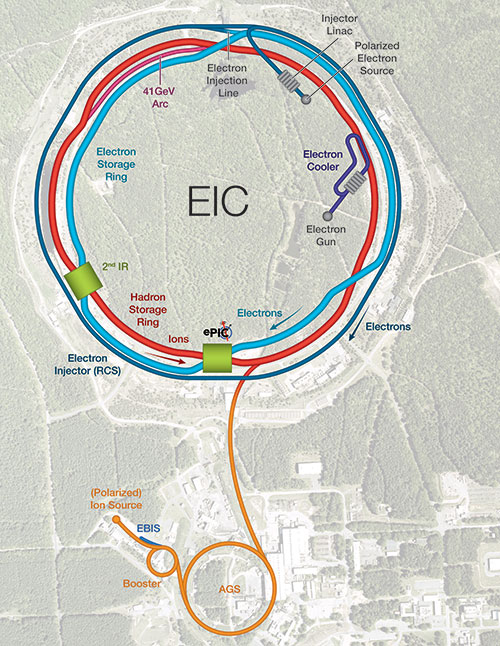Electron-Ion Collider Set to Begin Long-Lead Procurements
EIC project passes Critical Decision 3A (CD-3A), official OK to procure key components for building state-of-the-art collider
April 2, 2024
 enlarge
enlarge
A cutaway showing accelerator components inside the future Electron-Ion Collider tunnel. (Brookhaven National Laboratory)
UPTON, N.Y. — The U.S. Department of Energy (DOE) Under Secretary for Science and Innovation has approved Critical Decision 3A (CD-3A) for the Electron-Ion Collider (EIC), a state-of-the-art particle collider for nuclear physics research that will be located at DOE’s Brookhaven National Laboratory and built in partnership with DOE’s Thomas Jefferson National Accelerator Facility (Jefferson Lab). This milestone gives the project the formal go-ahead to purchase “long-lead procurements” — equipment, services, and/or materials that must be ordered well in advance of assembling the collider because of the long delivery times for such items.
“The EIC project can now move forward with the execution of contracts with industrial partners that will significantly reduce project technical and schedule risk,” said EIC Project Director Jim Yeck.
Purchasing materials and equipment needed to build sophisticated components for the EIC accelerator, detector, and supporting infrastructure prior to construction ensures, for example, that the team will be able to adjust for any supply chain issues and work out any technical details and challenges.
 enlarge
enlarge
A schematic of the planned Electron-Ion Collider over an aerial view of the Relativistic Heavy Ion Collider at Brookhaven National Laboratory. (Tiffany Bowman/Brookhaven National Laboratory)
“Passing this milestone and getting these procurements underway will help us achieve our ultimate goal of efficiently delivering a unique high-energy, high-luminosity polarized beam electron-ion collider that will be one of the most challenging and exciting accelerator complexes ever built. The DOE-Brookhaven-Jefferson Lab Integrated Project Team is ready to work together on this new phase,” Yeck said.
“I want to thank the Project Team members for their determination, resourcefulness, and dedication in reaching this important project milestone,” said EIC Project Manager Luisella Lari. “This long lead procurement approval will allow both Brookhaven and Jefferson Lab to proceed full speed ahead on the EIC to bring its exciting physics results and other benefits to society.”
“This authorization for long-lead procurements would not have been possible without the dedicated work and support of many people here in the U.S. and internationally,” said Jim Fast, Jefferson Lab's associate project manager for EIC. “We are eager to continue this partnership between Brookhaven and Jefferson Lab in collaboration with our many colleagues. This commitment by the DOE underscores the worldwide interest in the science that will be enabled by the EIC and fosters international partner commitments for in-kind contributions to the EIC.”
The EIC, funded primarily by the federal government through the DOE Office of Science, will be a 2.4-mile-circumference particle collider, the first of its kind in the world. It will steer beams of high-energy polarized electrons into collisions with polarized protons and atomic nuclei to produce precision 3D snapshots of those particles’ internal structures. Experiments at the EIC will help scientists unlock the secrets of the strongest force in nature and explore how tiny particles called quarks and gluons build up the mass, spin, and other properties of essentially all visible matter.
The world-leading science that the EIC will enable and the technological innovations needed to make it a reality have the potential to inspire the technologies of tomorrow.
Long-lead purchases for project readiness
The EIC project will draw on expertise throughout the DOE national laboratory system and from universities and research institutions worldwide. The total project cost is expected to fall in the range of $1.7-2.8 billion.
The current approval for long-lead procurements (LLPs) will allow the purchase of approximately $90 million in materials and items. These include superconducting wires and materials for making magnets, cryogenic equipment for superconducting accelerator devices, lead tungstate crystals and scintillating fibers for detectors, substations for new power-supply and support infrastructure buildings, and other specialized accelerator and detector components. The equipment will be purchased from industrial technology specialists through Brookhaven’s and Jefferson Lab’s full and open-competition procurement processes. Purchasers will prioritize U.S.-based small and/or women-/veteran-/minority-owned businesses.
Funding for LLP purchases will come, in part, from Inflation Reduction Act funding awarded to the EIC project in 2022 to stimulate economic development and through annual appropriations funding from the DOE Office of Science. Equipment and materials will be delivered to Brookhaven Lab and Jefferson Lab, where experts will assemble, test, and troubleshoot components to ensure readiness for installation when construction begins.
The EIC construction plan makes use of key infrastructure of the Relativistic Heavy Ion Collider (RHIC) at Brookhaven, with the majority of EIC accelerator components designed to fit within the existing RHIC tunnel. The project will also reuse additional key infrastructure.
Project timing is planned to make optimal use of the highly skilled RHIC accelerator workforce in a seamless way when RHIC operations conclude. Making early procurements will ensure that equipment required to be installed at that time is in place so these scientists, engineers, and technicians can pivot to EIC assembly as soon as RHIC operations cease.
Benefits for science and society
Building the EIC will maintain U.S. leadership in nuclear physics and accelerator science — fields that are crucial to our technological, economic, and national security. The project will also provide educational and workforce development opportunities to train the next generation of experts in these fields.
In addition, the technological advances already under development to make the EIC a reality — innovative accelerator and particle-tracking components and data-management tools and techniques — could have widespread impacts. These include new approaches to cancer therapy, solving other “big data” challenges, and improving accelerator facilities for testing batteries, catalysts, and other energy-related materials.
The knowledge stemming from research at the EIC will be published in the open scientific research literature and will be available to all partners, including commercial partners.
The collider-accelerator infrastructure that powers the EIC at Brookhaven will also be available to researchers who use particle beams to produce and conduct studies on isotopes for medical, national security, and industrial applications, and to researchers who study the effects of simulated space radiation with the aim of protecting future astronauts.
Brookhaven National Laboratory is supported by the Office of Science of the U.S. Department of Energy. The Office of Science is the single largest supporter of basic research in the physical sciences in the United States and is working to address some of the most pressing challenges of our time. For more information, visit science.energy.gov.
Follow @BrookhavenLab on social media. Find us on Instagram, LinkedIn, X, and Facebook.
2024-21812 | INT/EXT | Newsroom









